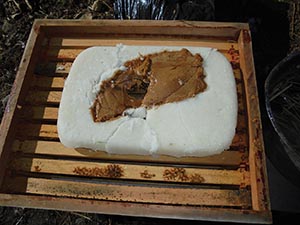
Spring is the most dangerous time of year for honey bees.
They typically begin brood rearing at about the winter solstice, and thus need to keep the brood chamber warmer for the babies, besides producing all those extra mouths to feed. This is when they really begin to use up their honey stores more rapidly. If the winter has been warm enough for the bees to fly frequently, they will be even closer to the knife edge of starvation, since flying requires elevated caloric expenditures.
An extended early warm spell can encourage bees to forage fruitlessly, expending even more calories than cleansing flights would burn up. If the early foraging yields early pollen, the situation becomes even more dire, since incoming pollen induces more enthusiastic brood rearing, even more mouths to feed, and even faster honey consumption. Early pollen producing plants often do not produce nectar, so there is no food coming in to feed adult bees.
We do the winter check in February these days in most of the country. Our main job is to ascertain whether the bees have enough honey remaining. In Langstroth beekeeping all we need do is to tip the hive either from the back or from the side, just enough that you can feel its weight. It should feel fairly heavy. Keep in mind that besides the honey, there is the wood, frames and foundation, combs, top and bottom and five to seven pounds of bees. If you forgot to heft the hive in the fall and have no point of reference, you may not feel confident in your assessment. If the hive feels too light, or you aren’t sure if the bees have enough honey left, you may need to visually check on the bees.
I am not suggesting that you remove combs, or in any way disturb the cluster. A visual check should be done on the warmest day available (50 degrees is nice). Pop the covers and just see where the bees are. If they are in the topmost hive body against the lid, it likely means that they have eaten the honey below. Even if that box is full of honey (and you can’t really tell without removing frames), it will not hurt at all to place some emergency sugar rations.
If you must pop the top, do it quickly and have everything you might need on hand so that one opening will do the job. A sheet of newspaper laid on top of the frames with room around the edges to allow the bees to come up, and covered with 4 pounds of plain white sugar is wonderful emergency food. This is called the mountain camp method of feeding bees.
If you plan ahead, you can make bee candy instead. Bee candy has the added value of incorporating a tiny bit of water, making it more readily consumable by the bees. Both bee candy and mountain camp feeding give one more benefit to the colony: They absorb moisture that might otherwise rain back down on the bees. In fact, bees cannot use dry sugar. We are relying on water absorption to make the sugar available for the bees’ consumption. If you placed mountain camp or bee candy in the hive in fall, all you need to do is check to see if it is still there. If it is bone dry, a quick spritz with a spray bottle of water will remedy the situation.
Either of these two methods of feeding requires a shim, or “eke”, to allow space for the sugar. Hopefully, you put this on in the fall, so that the bees could propolize it down. If time got away from you and you are placing the eke now, you will need to duct tape it to the hive body below, all the way around. Bees need ventilation in winter, but not quite as much as would happen with a hive body or eke not propolized in place.
This brings us to our next winter job, ventilation check. We humans think we need to help our bees keep warm, which is completely untrue. In one of my out-yards, I once discovered a colony whose outer cover had blown off. The inner cover stayed on due to all that wonderful propolis. It had snowed several times, and the wind had been blowing. The bees were fine, even though the inner cover had that big opening in the middle and snow could go right into the hive. They survived the winter, and came out strong in the spring. (Yes, I did replace the outer cover and used a strap this time).
In fact, our attempts to help the bees stay warm can be detrimental if by so doing we decrease their ventilation too much. If the inside of the inner cover appears dry, nothing more is needed. If it is wet, or mold is appearing on the tops of the frames, a bit of air at the top of the hive is the answer. If your inner cover has a slot in the rim, place it toward the front of the hive, so that air goes in the lower entrance, straight up and out the top, pulling moisture with it. Putting that slot at the back of the hive would pull air through the cluster, and we don’t want that. If there is no slot in the inner cover, a piece of a Popsicle stick under each front corner of the inner cover is the trick for you.
Remember that the lower entrance needs to be clear. Snow and ice can keep even oxygen out, and definitely keeps bees in when ….


